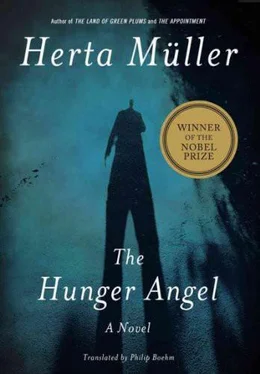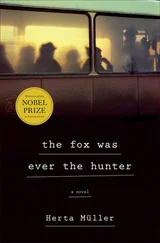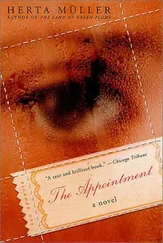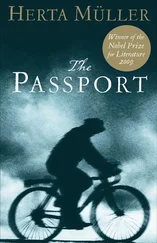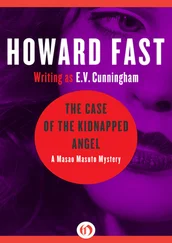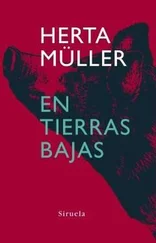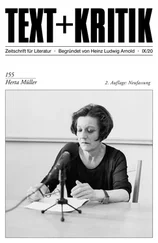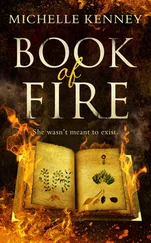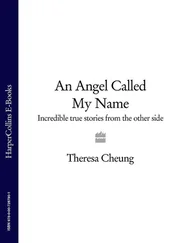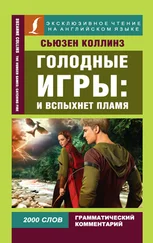You can’t flex your toes in wooden shoes. You can’t lift your feet, either, you have to slide them. Your knees get stiff from the shuffling. It was a relief when the cloth tore at the heels, because then your toes had a little more room, and you could bend your knees more easily.
The wooden shoes had no right or left, and only three sizes: tiny, gigantic, and, very rarely, medium. To find two shoes of the same size you sifted through the pile of wood and sackcloth in the clothes room. Not only was Bea Zakel Tur Prikulitsch’s mistress—she was mistress of our clothes. Some people she helped rummage for two well-nailed shoes. With others she merely slid her chair closer to the pile of shoes, without so much as bending over, and lurked there to make sure nothing was stolen. She herself had a good pair of low shoes made of leather, and felt boots for when it was icy cold. If she had to run through the mud she’d pull on her rubber galoshes.
The camp administration expected the wooden shoes to last half a year. But the cloth tore at the heels after three or four days. So, in addition, everyone tried to barter his way into a pair of galoshes. These were flexible and light, several sizes larger than your foot. There was ample room for several layers of rags—footwraps—which we used instead of socks. To keep your feet from slipping out of the galoshes, you ran wire under the sole and tied it off on top, at the instep. The wire knot chafed, so the top of your foot was always raw. And that sensitive spot always got the first chilblains. Throughout the winter, both the wooden shoes and the galoshes froze to the footwraps. And the footwraps froze to the skin. The rubber galoshes were even colder than the wooden shoes, but they lasted for months.
Our work clothes—we had nothing else—in other words, the camp uniforms, were distributed every six months. They were the same for men and women. Apart from the wooden shoes and rubber galoshes, we were given underwear, padded suits, work gloves, footwraps, bedding, towels, and one piece of soap that had been chopped off a bar and smelled strongly of lye. The soap burned the skin and had to be kept away from any open sores.
The underclothes were made of unbleached linen: 1 pair long underwear, with ties at the ankles and in front at the stomach, 1 pair short underwear with ties, 1 undershirt with ties, which was really an all-purpose, underoverdaynightsummerandwintershirt. The fufaikas had rolls of padding that ran the length of the garment. The pants had a wedge cut for fat stomachs and tight cuffs that laced at the ankles. There was a single button in front, at the waist, and pockets on either side. The jacket was shaped like a sack with a standing collar known as a rubashka- collar, and had cuffs with one button on each sleeve, a row of buttons in front, and two square pockets sewn onto the sides. For a head covering, both men and women were issued quilted caps with earflaps and laces.
The fufaikas were blue-gray or green-gray, depending on how the dye had taken. But after a week’s work, they all turned brown and stiff from the dirt. The fufaikas were a good thing, the warmest clothing for the dry winter, when the frost sparkled and your breath froze on your face. And in the scorching summer they were roomy enough to let the air circulate and the sweat dry. But in wet weather they were miserable. The padding soaked up the rain and snow and stayed wet for weeks. Our teeth chattered and we suffered from extreme cold until evening, when we could finally return to the barrack. And in the barrack, given the 68 bunks and 68 internees with their 68 fufaikas, 68 caps, 68 pairs of footwraps, and 68 pairs of shoes, the air was stuffy and oppressive. We lay awake and stared at the lightbulb. The yellow gleam seemed to contain melting snow. And in the melting snow was the stench of the night, covering us with forest earth and moldy leaves.
After work, instead of going back to the camp, I went begging in the Russian village. At the UNIVERMAG the door was open but the store was empty. The saleswoman was bending over a shaving mirror on the counter, checking her head for lice. A gramophone was playing next to the shaving mirror, taa-tatata-taa. I recognized the melody from the radio back home: Liszt, announcing special bulletins from the war. My father had bought the Blaupunkt with the green cat eyes in 1936 for the Berlin Olympics. In these exciting times, he had said. The Blaupunkt paid off, because the times got even more exciting.
Three years later, at the beginning of September, it was once again time for cold cucumber salad in the shade on the veranda. The Blaupunkt sat on the little corner table, hanging on the wall next to it was the large map of Europe. Taa-tatata-taa: Special News Bulletin. Father tipped his chair to reach the knob on the radio and turned up the volume. We all went silent and stopped clattering with our silverware. Even the wind listened through the windows on the veranda. What had started on September 1, my father called Blitzkrieg. My mother called it the Polish Campaign. My grandfather, who had sailed around the world as a cabin boy on a big frigate out of Pola, was a skeptic. He was always interested in what the English had to say. When it came to Poland, he preferred to keep quiet and take another spoonful of cucumber salad. My grandmother said that dinner was a family affair and not the place for politics on the radio.
My father had cut out several little red triangular flags—victory banners—and affixed them to pins with colorful heads. He kept them in the ashtray next to the Blaupunkt. For 18 days Father moved his little flags eastward on the map. That was it for Poland, said Grandfather. And for the little flags. And for the summer. My grandmother plucked the little flags off the map of Europe and returned the pins to her sewing box. The Blaupunkt migrated to my parents’ bedroom, three walls away. At the crack of dawn I heard the wake-up broadcast from Radio Munich. The program was called Morning Gymnastics, and the floor began to vibrate rhythmically. Led by the gymnastics instructor in the Blaupunkt, my parents performed their exercises. And since I was too chubby and they wanted me to be more soldierly, my parents sent me once a week to a private exercise class that most people called Gymnastics for Cripples.
Yesterday an officer wearing a green cap the size of a cake platter gave a speech at the roll-call grounds, the Appellplatz. He spoke about peace and FUSSKULTUR, which sounded to us like the culture of feet. Tur Prikulitsch couldn’t interrupt, he stood next to the man like a devout acolyte, then summarized the contents of the speech: Fusskultur strengthens our hearts. And in our hearts beats the heart of the Soviet Socialist Republics. Fusskultur steels the strength of the working class. Through Fusskultur the Soviet Union will blossom in the strength of the Communist Party and in the peace and happiness of the people. Konrad Fonn, the accordion player, who came from the same region as Tur Prikulitsch, told me that Y in the Cyrillic alphabet was like our U, and that the speech was all about the power of physical training, which the Russians call FISKULTURA. The officer had evidently tried to re-create the word in German and come up with PHYS-KULTUR, but had read the German Y like a Cyrillic U, and Tur didn’t dare correct him.
I knew all about FUSSKULTUR from the cripple gymnastics and from our Volk course in high school, which we had to attend every Thursday. We drilled in the schoolyard: lie down, stand up, climb the fence, squat, lie down, push up, stand up. Left, right, march, sing songs. Wotan, Vikings, Germanic ballads. On Saturdays or Sundays we would go on marches out of town. We trained in the brush on the hills, we used branches for camouflage, we practiced finding our way with owl calls and dog barks, and played war games wearing red and blue woolen threads. If you tore the thread off an enemy you had killed him. The person with the most threads was decorated as a hero, a blood-red rose hip serving as a medal.
Читать дальше
